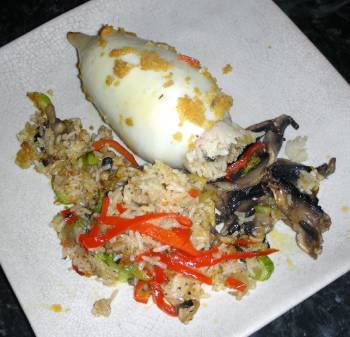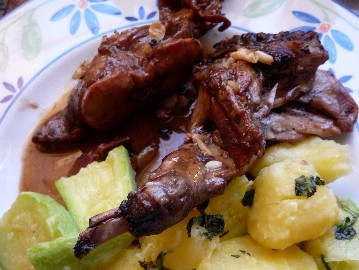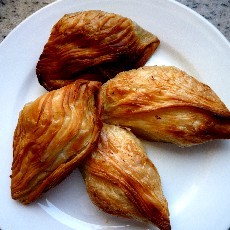Maeve O’Meara explores a different take on Mediterranean cooking with the rustic delights of Maltese food. Chef Paul Camilleri of Restaurant Sojourn takes Maeve through the essential ingredients and then cooks a beloved family recipe for the national dish, stuffat tal fenek or rabbit stew. The dish is served as two courses—the rich tomato based sauce it cooks in with pasta, and the tender rabbit with vegetables.
We explore what makes the national snack food pastizzi so delicious with the Hili family at Gato’s Pastizzi who started making the flakey baked pastries in the late 1950s. With rising Melbourne chef Shane Delia, we learn about the national sandwich called hobs biz zeit–raw tomato paste spread on crusty bread and topped with traditional ingredients like anchovies, capers and olive oil.
Chef Louis Bigeni shows how the Maltese have modified recipes from their neighbors, taking pasta to a different level with a rich meat sauce and baked in pastry—its called timpana and no Maltese get-together is complete without this deep golden pie.
We learn about the soft ricotta style cheeses (Ġbejna) and harder mature cheese loved by the Maltese, and meet Polly Vella, who missed them so much when she came to Australia, she decided to train as a cheese-maker and make them herself. Her daughter Alex, a civil engineer, serves a small round of creamy in her classic vegetable-based soppa ta l'armla (widow’s soup). Polly then whips up bragioli, also known as beef olives, for lunch and shares her easy recipe.
Finally broadcaster Rita O’Dwyer makes a delcious dessert/sweet snack called puddina—a chocolate bread and butter custard meets panforte.
Click here for the recipes featured in this episode.
Maltese Cuisine
 Reflecting Maltese history, Maltese cuisine shows strong Sicilian and English influences as well as influences of Spanish, Maghrebin and Provençal cuisines.
Reflecting Maltese history, Maltese cuisine shows strong Sicilian and English influences as well as influences of Spanish, Maghrebin and Provençal cuisines.
Malta's history and geography had an important influence on its cuisine. Having to import most of its foodstuffs, lying on the most important trade crossroads, and having to cater for foreign powers who ruled the islands, opened Maltese cuisine to outside influences from very early on. Foreign dishes and tastes were absorbed, transformed and adapted. Thus, the geographical proximity of Sicily exerted a strong influence but the presence in Malta of the Knights of St John and, more recently, the British brought elements from further afield.
The Knights hailed from many European countries particularly France, Italy and Spain. They brought influences from these countries. Aljotta; for example, a fish broth with plenty of garlic, herbs and tomatoes is the Maltese adaptation of the bouillabaisse. The Knights' contacts and wealth also brought food from the New World. The British military presence meant a market of a garrison and their families and, later, mass tourism from the UK. British food products, condiments and sauces like English mustard, Bovril, HP Sauce and Worchestershire sauce are still a subtle but pervasive presence in Maltese cooking.
Despite Malta's small size there are some regional variations. The traditional Maltese fenkata (eating stewed rabbit) is often identified as the national dish. The strongest seasonal variations are seen in desserts and sweets.
Meats:
 Pork is probably the most universally eaten meat, followed by local rabbit (fenek), mainly imported beef and local chicken and turkey. Imported lamb and veal are also popular. Game birds like quail (summien), which are now farmed, turtle doves (gamiem) and wild pigeons (bċieċen) are also popular. Offal and organ meats like pork liver and kidneys, tripe, brain, tongue, heart, stomach and tail also form part of the cuisine. They are less popular today than in the past when the fine cuts of meat were not within everyone's reach.
Pork is probably the most universally eaten meat, followed by local rabbit (fenek), mainly imported beef and local chicken and turkey. Imported lamb and veal are also popular. Game birds like quail (summien), which are now farmed, turtle doves (gamiem) and wild pigeons (bċieċen) are also popular. Offal and organ meats like pork liver and kidneys, tripe, brain, tongue, heart, stomach and tail also form part of the cuisine. They are less popular today than in the past when the fine cuts of meat were not within everyone's reach.
In addition to pork dishes (such as grilled pork cuts or stuffed flank) and the exclusive predominance of pork in indigenous Maltese sausages, adding some pork to dishes such as kawlata (a vegetable soup) and ross il-forn (baked rice) have been common practice in the Maltese vernacular cuisine for centuries.
Popular meat dishes include: Stuffat tal-fenek (rabbit stew), Fenek moqli (fried rabbit), Braġjoli (thin slices of beef pan-fried in their own juice, or in a small amount of light olive oil, served with a green salad or boiled potatoes), Laħam fuq il-fwar (steamed slices of beef), Falda Mimlija (stuffed pig flank), Laħam taż-żiemel (stallion meat fried or baked in a white wine sauce), Zalzetta tal-Malti (Maltese sausage made of pork, sea salt, black peppercorns, coriander seeds and parsley), and Mazzita (blood sauage).
Fish is much eaten on the two islands and Maltese know from experience which fish is best baked, which poached, which grilled and which fried. Fish is often cooked and seasoned very simply but it may also be stuffed, stewed or made into pies. Many shellfish and crustaceans are also available and very popular.
Popular dishes include: Lampuki (or mahi-mahi), Stuffat tal-Qarnit (octopus stew), Qarnit bit-tewm (octopus with garlic), Klamar mimliji (squid stuffed with rice, breadcrumbs, parsley, garlic and capers and then gently stewing in red wine), and Pixxispad (marinated and grilled swordfish)
Vegetables:
Vegetables are a mainstay of Maltese cuisine. They are used stuffed or made into stews or they may be made into soups, fritters and pies.
Popular dishes include: Qargħabali mimli (stuffed courgette or marrows), Brunġiel mimli (stuffed aubergine), Bżar mimli (stuffed peppers), Patata l-Forn (baked sliced potatoes), Kapunata, and Aljoli (a pounded garlic sauce diluted with oil which may include dry savory biscuits called "galletti" or bread, and some fresh herbs like parsley, mint or marjoram, capers, olives, anchovies, and/or tomatoes.)
Breads and Pastries:
 Maltese bread is a very crusty sourdough bread loaf, with a deliciously fragrant chewy but soft inside. It is the mainstay of a meal. Maltese bread is best eaten fresh but cooled off, as it loses most of its taste and crunchiness within a day. Even so, some people prefer to eat when it is straight out of the oven. Although it can be eaten as accompaniment to food and with a variety of
fillings, the typical and favorite way to eat it is after it has been rubbed with tomatoes or tomato paste, drizzled with olive oil and filled with a choice or mix of tuna,
olives, capers, bigilla and Ġbejniet. There is also a low rise, less crusty and more compact flatbread called Ftira.
Maltese bread is a very crusty sourdough bread loaf, with a deliciously fragrant chewy but soft inside. It is the mainstay of a meal. Maltese bread is best eaten fresh but cooled off, as it loses most of its taste and crunchiness within a day. Even so, some people prefer to eat when it is straight out of the oven. Although it can be eaten as accompaniment to food and with a variety of
fillings, the typical and favorite way to eat it is after it has been rubbed with tomatoes or tomato paste, drizzled with olive oil and filled with a choice or mix of tuna,
olives, capers, bigilla and Ġbejniet. There is also a low rise, less crusty and more compact flatbread called Ftira.
Popular savory pastries include: Torta tal-Irkotta (ricotta pie), Sfineġ (vegetable, fish or cheese fritters), Pastizzi (cheesecakes or peacakes), Qassatat (snack made with shortcrust pastry, traditionally filled with ricotta, peas, spinach and anchovies), and Torta tar-ross u l-qargħa ħamra (rice and pumpkin pie).
Popular sweets include: Qagħaqa tal-ħmira (soft sweet bagel shape cake with a hint of aniseed, topped with sesame seeds), Torta tat-tamal (date and cocoa tart), Torta tal-marmorat (almond and chocolate pie), Ħelwa tat-Tork (nut studded sesame seed and tahini-based block confection), and Pudina tal-ħobż (baked bread pudding with raisins and cocoa powder).
Beverages:
Coffee scented with a piece of stick cinnamon is a popular beverage. Other spices like cloves and anis seeds are used singly or together to flavour Kafè Msajjar or "cooked" coffee, which may also be perfumed with orange blossom water or chicory.
Kinnie is a non-alcoholic, mildy and pleasantly bitter soft drink created in 1952 that is very popular and refreshing. Made from a citrus fruit called chinò and aromatic herbs, it is caramel in color.
Episodes:
 |
AFRICAN: Wherever you are in Africa, no meal is complete without a starchy porridge known as fufu. |
 |
BRAZILIAN: An exuberant, colorful mix of Portuguese, African and native foods including some from the Amazon. |
 |
CHINESE: Two thirds of households own a wok and use it regularly, but not everyone knows how to use it properly. |
 |
EGYPTIAN: Beans are used extensively and creatively as a source of protein, fibre, and comfort. |
 |
ENGLISH: "Meat & three veg" originated in the UK with dishes like roast beef, steak and kidney pie, and many more. |
 |
FRENCH: The French have elevated food into an art form. Nowhere else is so much attention paid to what people are going to eat and how. |
 |
HUNGARIAN: A fusion of simple peasant food & the elegant, highly developed cuisine from the days of the Austro Hungarian Empire. |
 |
INDIAN: A vibrant, intensely colorful cuisine. Each region of India has its own style of cooking and distinct flavors. |
 |
INDONESIAN: One of the most vibrant and colorful cuisines in the world, full of intense flavor and varied textures. |
 |
ITALIAN: An long-awaited introduction to the kitchens and restaurants of Australia’s top Italian chefs and home cooks. |
 |
JAPANESE: Refined and elegant, its preparation and presentation honed over the centuries so its flavors are pure and delicate. |
 |
JEWISH: While flavors of the Jewish palate are influenced by geography, the constant for Jews all over the world are the Kosher laws. |
 |
KOREAN: Some of the healthiest food on earth, with a near obsession with the fermented vegetable kimchi. |
 |
LEBANESE: Lebanese cuisine is generous and abundant, and this is some of the most exquisite food in the world. |
 |
MEXICAN: Authentic Mexican food is vibrant, spicy, delicious and fun. It varies according to which region its from. |
 |
MOROCCAN: One of the most cleverly balanced cuisines on earth; spices are used to enhance the flavor of dishes. |
 |
PAKISTANI: Full of marvelous and diverse dishes, it incorporates elements from its neighbors India, Afghanistan and Iran. |
 |
PERSIAN: From simple dips to hearty stews, food preparation is taken very seriously in Iran and is often a labor of love. |
 |
SOUTH AMERICAN: A fantastic fusion of culinary traditions from indigenous Indians, imported Africans, and the Spanish and Portuguese colonist. |
 |
SRI LANKAN: This beautiful spice island is a rich melting pot of every nationality that has visited and traded with it over the years. |
 |
SYRIAN: One of the highlights of Syrian food is mezza, a generous spread of small dishes and the prelude to even more food! |
 |
TURKISH: Nestled between Asia and Europe, Turkish food is an unique and exotic fusion with influences from many countries. |
Contact Us | Shop | Sitemap | Join Our Team | Investors | Advertise | Web Design Services
Community | Foodies' Choice | Meetup Groups | Chat | Blogs | Forums | Submit Your Site | Resources

